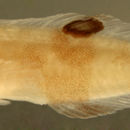en
names in breadcrumbs


Description: Body relatively thin, narrow and long with a large eye and a terminal, small mouth. Pectoral fins medium, reach to vent. Pelvic fins very short. Dorsal and anal-fin bases long, caudal peduncle short and relatively wide. Melanophores limited to the fin-ray membranes, typically occurring in five groups: at the front, mid, and rear dorsal fin and the front and rear anal fin. Each melanophore group covers from one to five fin spines or rays. Transitional recruits have a mid-dorsal fin ocellus, a white-edged black spot on the upper base of the central caudal-fin rays and a patchy pattern of melanophores along the body with a mid-body bar extending from the dorsal ocellus down onto the anterior anal-fin rays.
Diagnosis: The fin-ray count of D-IX,11 A-III,12 and Pect-13 indicates Halichoeres and is shared by most of the Caribbean species. Larval H. radiatus are identical to most other larval Halichoeres with five patches of median-fin melanophores and can only be identified by DNA sequencing.
The puddingwife wrasse, Halichoeres radiatus, is a species of wrasse native to the western Atlantic Ocean from North Carolina to Bermuda, through the West Indies and Gulf of Mexico, to offshore islands of Brazil, being absent from Brazilian coastal waters.[3] It can be found on reefs at depths from 2 to 55 m (6.6 to 180.4 ft), with younger fish up to subadults being found in much shallower waters from 1 to 5 m (3.3 to 16.4 ft). This species can reach 51 cm (20 in) in total length, though most do not exceed 40 cm (16 in). This species is of minor importance to local commercial fisheries and can be found in the aquarium trade.[2]
The puddingwife wrasse, Halichoeres radiatus, is a species of wrasse native to the western Atlantic Ocean from North Carolina to Bermuda, through the West Indies and Gulf of Mexico, to offshore islands of Brazil, being absent from Brazilian coastal waters. It can be found on reefs at depths from 2 to 55 m (6.6 to 180.4 ft), with younger fish up to subadults being found in much shallower waters from 1 to 5 m (3.3 to 16.4 ft). This species can reach 51 cm (20 in) in total length, though most do not exceed 40 cm (16 in). This species is of minor importance to local commercial fisheries and can be found in the aquarium trade.